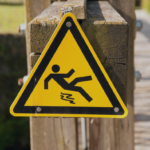5 Hidden Workplace Dangers You Need to Know
While many workplace hazards such as rickety ladders, heavy equipment, slick floors, and unstable surfaces present obvious safety risks, many dangers aren’t so easily detectable. While a climate controlled office is generally safer than a construction site, even that isn’t immune to hidden dangers. Here’s a quick rundown of hidden dangers to be aware of.
- Slips, trips, and falls: These accidents are the most common type of injury, regardless of the type of workplace. In the office environment, this can be caused by objects such as boxes, files, and various items left in walkways. In addition to posing an electrical hazard, stretching cords across walkways or under rugs can present a tripping hazard as well, so it is important to ensure all cords are properly secured and covered. Skid-resistant surfaces can also help to reduce falls, particularly in wet conditions.
- Obstructed vision: Obstructed vision can present another hazard regardless of worksite. Workers can collide with each other in areas with blind corners or walls, which can be especially hazardous where heavy equipment is in use. Using convex mirrors at intersections and eliminating obstructions can help reduce collisions.
- Fatigue: A 2018 study by the National Safety Council (NSC) found that 90% of employers were negatively impacted by tired employees. Along with 57% reporting increased employee absenteeism, 32% reported injuries and near-misses due to fatigued employees. According to OSHA, long work hours and evening, night, or irregular shifts contribute to worker fatigue, which in turn increases the risk of injuries and accidents. These can also lead to increased levels of stress, poor eating habits, lack of physical activity, and illness. It is important to recognize the signs of worker fatigue and its potential impact on the health and safety of each worker.
- Ergonomics hazards: Ergonomics-related injuries are one of the most common injuries in the office setting as well as at industrial worksites involving repetitive work. These can be difficult to detect, however, as injuries take time to develop. Over time, poorly designed workstations and repetitive movements can lead to musculoskeletal problems, poor posture, eye strain, and repetitive stress injuries. In the office environment, OSHA’s Computer Workstations eTool can help create a safer, healthier workspace.
- Electrical fire hazards: According to OSHA, workplace fires and explosions kill 200 and injure over 5,000 workers each year, costing businesses over $2.3 billion in property damage. Of these, 22% of workplace fires are electrical – damaged and ungrounded power cords pose serious fire hazards and violate safety codes. Improperly used and/or overloaded extension cords can also present fire hazards.
Space heaters present another fire hazard. Supervisors should verify that they are approved for commercial use and are designed to shut off automatically if tipped over. Also, they should not be powered with extension cords or placed near combustible items.
Along with employee safety training and improved equipment, supervisors can ensure a safer workplace by remaining alert to hidden dangers and communicating with employees on a regular basis. Establishing an anonymous employee reporting system is another good way for organizations to be aware of potential hazards before they cause injury. Ultimately, this will benefit not only the employees, but also the company’s bottom line.


